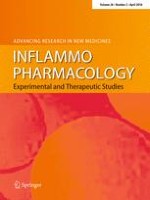28.07.2017 | Original Article
Acid-gastric antisecretory effect of the ethanolic extract from Arctium lappa L. root: role of H+, K+-ATPase, Ca2+ influx and the cholinergic pathway
Erschienen in: Inflammopharmacology | Ausgabe 2/2018
Einloggen, um Zugang zu erhaltenAbstract
Background
Arctium lappa L., popularly known as burdock, is a medicinal plant used worldwide. The antiulcer and gastric-acid antisecretory effects of ethanolic extract from roots of Arctium lappa (EET) were already demonstrated. However, the mechanism by which the extract reduces the gastric acid secretion remains unclear. Therefore, this study was designed to evaluate the antisecretory mode of action of EET.
Materials and methods
The effects of EET on H+, K+-ATPase activity were verified in vitro, whereas the effects of the extract on cholinergic-, histaminergic- or gastrinergic-acid gastric stimulation were assessed in vivo on stimulated pylorus ligated rats. Moreover, ex vivo contractility studies on gastric muscle strips from rats were also employed.
Results
The incubation with EET (1000 µg/ml) partially inhibited H+, K+-ATPase activity, and the intraduodenal administration of EET (10 mg/kg) decreased the volume and acidity of gastric secretion stimulated by bethanechol, histamine, and pentagastrin. EET (100–1000 µg/ml) did not alter the gastric relaxation induced by histamine but decreased acetylcholine-induced contraction in gastric fundus strips. Interestingly, EET also reduced the increase in the gastric muscle tone induced by 40 mM KCl depolarizing solution, as well as the maximum contractile responses evoked by CaCl2 in Ca2+-free depolarizing solution, without impairing the effect of acetylcholine on fundus strips maintained in Ca2+ -free nutritive solution.
Conclusion
Our results reinforce the gastric antisecretory properties of preparations obtained from Arctium lappa, and indicate that the mechanisms involved in EET antisecretory effects include a moderate reduction of the H+, K+-ATPase activity associated with inhibitory effects on calcium influx and of cholinergic pathways in the stomach muscle.
Anzeige











